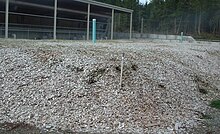
In the United States, vehicle safety inspection is goverened by each state individually. 18 states have a periodic (annual or biannual) safety inspection program, while Maryland requires an inspection prior to registration or transfer of ownership only.
Under the Clean Air Act (1990), states are required to implement vehicle emission inspection programs in metropolitan areas whose air quality does not meet federal standards. The specifics of those programs vary from state to state. Some states, including Kentucky and Minnesota, have discontinued their testing programs in recent years with approval from the federal government.
In most states, such inspections are done at state-operated garages, usually near the local DMV office. Pennsylvania is a notable exception, instead opting to have privately-owned garages doing inspections with approval from PennDOT. The flip side to this though is that some independently-run garages will do what is commonly known in Pennsylvania as a "lick-'em-and-stick-'em", which simply has the person pay the inspection fee and has the sticker replaced without actually checking the vehicle. This is illegal in Pennsylvania, which among other penalties could lead to a fine for the garage and a revocation of their inspection privileges. Other independently-run garages as well as chains like Pep Boys, Midas, and car dealerships are more stringent and follow PennDOT guidelines for inspections.
States and Federal Districts with periodic (e.g., annual) vehicle safety inspections
* Delaware (every year or every two years; brand new cars are exempt for the first four years provided the car remains with the same owner. Older cars registered as antiques do not require emissions testing.)
* District of Columbia (every two years; the requirement for safety inspection for private cars will end October 1, 2009)
* Hawaii (every year, except brand new vehicles receive an inspection valid for two years, emergency vehicles, school vehicles, rental cars, vehicles used in public transportation, and other, every six months)
* Louisiana (every year; emission test in the Baton Rouge metropolitan area parishes of Ascension, East Baton Rouge, Iberville, Livingtston and West Baton Rouge)
* Maine (every year; emission test in Cumberland County)
* Massachusetts (safety inspection and emissions testing annually). In 2008 the tailpipe test for 1995 model year and older vehicles was discontinued, vehicles without OBD-II systems receive a visual check of exhaust components
* Mississippi (safety inspection every year)
* Missouri (Odd numbered model year renews in odd numbered year, even model year renews in even year, except new vehicles not previously titled which are exempt during the model year and the year following, or vehicles displaying historical plates, which are completely exempt.; emissions testing in St. Louis city, St. Louis County, St. Charles County, Franklin County, and Jefferson County)
* New Hampshire (annually, emissions testing for model year 1996 and newer vehicles))
* New Jersey (safety and emissions testing every two years, brand new cars are exempt for the first four years. Effective 2010, the new car four-year exemption will transfer to the next owner if sold before the end of the four years . Older cars registered as antiques do not require emissions testing. Diesel cars under 10000 lb are also exempt.
* New York (annual safety and emissions). Model year 1996 and newer vehicles are subject to an OBD-II emissions inspection while older cars receive a visual check of exhaust components. Vehicles registered in the five boroughs of New York City as well as Long Island, Westchester County and Rockland County require a tailpipe smog-test if they are not OBD II equipped. All OBD II vehicles in those areas (1996 model year or newer) require only the OBD II test. And any vehicle 26 model years old or more does not require an emissions check of any sort. Newly registered vehicles from another state with a current inspection sticker are exempt until the out-of-state sticker expires or for one year, whichever is sooner.
* North Carolina (every year; emissions inspections in 48 of 100 counties (1996-newer, except new cars), exempting diesels and cars 35 years or older. Starting Nov 1, 2008 there won't be an inspection decal issued upon passing. )
* Pennsylvania every year for most vehicles; every six months for tractor-trailers, school vehicles (including school buses and school vans), motor coaches, mass transit buses, ambulances, fire department trucks, etc.; emissions inspections every year in 25 of 67 counties (stricter in the Pittsburgh and Philadelphia metro areas) (no emission inspection for diesel vehicles))annual inspection, emission, and semi-annual inspection stickers are color-coded, which tells which month of the year they expire. This makes it easier for police to be aware of expired stickers.
* Rhode Island (safety and emission inspection every two years)
* Texas (every year; emission test in the largest urban areas - Houston Metro, Dallas Metroplex, Austin, San Antonio, and El Paso)
* Utah (every two years for the first eight years, then every year)
* Vermont (every year)
* Virginia (every year; emission inspection every two years in urban and suburban jurisdictions in Northern Virginia)
* West Virginia (every year - safety)
States with safety inspection only required prior to sale or transfer * Alabama
* Maryland (emission inspection required every two years in all counties)(not required in every county. The VEIP testing network consists of 18 centralized inspection stations located in 13 counties and Baltimore City)
States which only require federally mandated emissions inspections * Arizona (Phoenix and Tucson metro areas only) annually, depending on age and type of vehicle)
* California (for most ZIP codes, every two years for all vehicles made after 1975 which are more than six years old)
* Colorado (in some localities, every year or two, depending on age and type of vehicle)
* Connecticut (every two years)
* Georgia (metropolitan Atlanta area only, every year, most recent three model year cars are exempt)
* Illinois every two years after the vehicle is four years old (Chicagoland and eastern suburbs of St. Louis, Missouri)
* Indiana (Lake and Porter counties only, every two years)
* New Mexico (Albuquerque metro area)
* Nevada (Clark County and Washoe County areas)
* Ohio (Cuyahoga, Geauga, Lake, Lorain, Medina, Portage, and Summit counties only) cars that are four years old or less do not have tested, after that period they have to tested. Testing is based on a odd-even year system. If a car was bought in 2000, it wont tested until 2010, if a car was purchased in 2003, then it will need to be tested in 2009. Franklin County (Columbus) and Hamilton County (Cincinnati) will also have be under emission testing effective in 2010. Ohio does not charge a fee for emission testing, due to Ohio's tobacco settlement.
* Oregon (Portland and Medford metro areas only)
* Tennessee in conjunction with annual registration renewal (Davidson, Hamilton, Rutherford, Sumner, Williamson or Wilson counties and city of Memphis only)
* Washington (urban areas of Clark, King, Pierce, Snohomish and Spokane counties)
* Wisconsin (Kenosha, Milwaukee, Ozaukee, Racine, Sheboygan, Washington and Waukesha; every two years)
States requiring an inspection only when bringing a vehicle from another State or jurisdiction * Nebraska (all vehicles, ATVs, minibikes and trailers brought into Nebraska from Out-of-State)
States without safety or emissions inspections * Alaska
* Arkansas
* Florida
* Idaho (Ada County has a county level program that requires testing)
* Iowa
* Kansas
* Kentucky
* Michigan
* Minnesota
* Montana
* North Dakota
* Oklahoma
* South Carolina
* South Dakota
* Wyoming
From http://en.wikipedia.org/
















